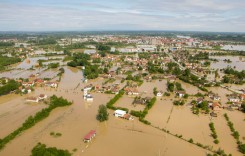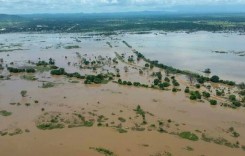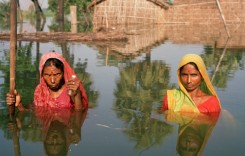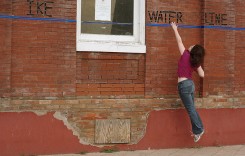Hurricane Matthew made landfall as a Category 4 hurricane near Les Anglais in the Sud Department of Haiti during the morning of 04 October 2016.
The storm dropped significant amounts of rain on Hispaniola Island, both in Haiti and in the neighbouring Dominican Republic.
As much as 233.9 mm of rain was recorded in a 24 hour period on 03 October 2016 at the Jardin Botanico station in Santo Domingo, Dominican Republic. All the meteorological stations in the southwestern region of the country recorded more than 100 mm of rain during that period.
Initial reports suggest that at least 2 people have died in Haiti, with a further 3 deaths as yet unconfirmed. In the Dominican Republic, officials have confirmed 4 people have died as a result of the hurricane.
Hurricane Matthew formed on Wednesday 28 September 2016 near the Windward Islands. As a tropical storm it caused damage in Saint Lucia, Martinique, Dominica and Saint Vincent, where at least one person died.
Matthew turned northward on 01 October, briefly strengthening to a Category 5 Hurricane, with sustained winds of up to 230 km/h, then dropping to Category 4.
Dominican Republic
Red level warnings were issued for the majority of Dominican Republic’s provinces, with the remainder under yellow level alerts.

According to Dominican Republic National Civil Defence authorities, 4 people have died, 13 houses severely damaged, 3 houses destroyed and more than 18,000 people displaced. At least 43 people were rescued by emergency services.
In a press conference late yesterday, civil defence officials said that 17 shelters had been set up in 11 provinces in order to house around 800 people displaced from their homes. Officials added that 17,751 people had evacuated their homes and moved to the homes of relatives and friends in safer locations.
Parts of the country have been hit hard by heavy rainfall. Street flooding has been reported and river levels are high, in particular the Yabacao River which has overflowed.

Haiti
The municipalities of Les Cayes, Les Anglais and Tiburon in Sud Department and Jérémie in Grand’Anse Department suffered the worst of the impact. Some street flooding was also reported in Port-au-Prince and Leogane.
According to the Ministry of Interior, as many as 11 coastal villages have been partially inundated by the storm surge.
Between 10,000 to 15,000 people have been moved to safe shelters. Nevertheless, many ignored the warnings and refused to leave their homes, fearing for their belongings.
Damage to roads and communication towers has been reported, hampering the emergency response and damage assessments. A bridge at Petit Goave has also been washed away.
Since the hurricane made landfall, the Haitian government have confirmed damage to over 1,500 homes and 2 fatalities. However, with full damage assessments yet to be carried out, the situation could be far worse.
Jean-Michel Vigreux, Country Director of CARE Haiti, sent an update late on 04 October, when the hurricane was passing directly over the southern peninsula of Haiti. He said:
“The southern part of Haiti has been particularly heavily hit and is now cut off from the rest of the country. The impacts of Matthew there are hard to evaluate as communication is very difficult, but we know of floods, landslides and continuous heavy rains in some areas of the South.
“We currently hear of 5 deaths but this will increase. CARE prepares a response for 8,000 to 10,000 families, that means 50,000 people.”
EU Aid to Haiti
Matthew is the worst storm to hit Haiti in the last decade and the effects could be catastrophic given the poor conditions in a country which has not yet fully recovered from the catastrophic 2010 earthquake.
A large part of the population still lives in precarious conditions or tents, highly vulnerable both to flooding and to subsequent standing water threats. Significant danger could come from contaminated water, with the risk of contracting dangerous diseases. According to UNICEF, more than 4 million children could be now exposed to water borne diseases.
European Commissioner for Humanitarian Aid and Crisis Management Christos Stylianides earlier today reaffirmed the EU’s commitment to disaster risk reduction and response by announcing that the European Commission is to provide €255,000 to fund humanitarian assistance for those most affected in Haiti.
“Impacts of disasters are increasing severely and Hurricane Matthew is just another example of it. The European Union remains committed in helping vulnerable communities in Haiti, the Caribbean and worldwide. Since 1994, the European Commission has granted €514.3 million in humanitarian aid to the Caribbean, of which €53 million has been allocated to help communities prepare and strengthen their resilience through Disaster Risk Reduction programmes.
“Today’s additional funding will provide immediate relief to people affected by Hurricane Mathew in Haiti by providing temporary shelters, health services, safe drinking water and sanitation,” he said.
Haiti is vulnerable to natural hazards due to its geography; it is exposed to hurricanes, floods, landslides, droughts and earthquakes.
Weak infrastructure further impedes the country’s resilience to natural hazards. Haiti has long been the poorest country in the Western hemisphere, with 58.5% of the population living under the poverty line. Access to basic healthcare services is limited. Populations have little coping capacities, and even minor natural hazards can have a huge impact on the population.
Cuba
Hurricane Matthew reached Cuba late on Tuesday afternoon, 04 October, 2016, making landfall on the eastern tip of the island.
AFP reports that Cuban authorities evacuated some 1.3 million people. Officials reported significant flooding and waves up to five meters (16 feet) in coastal villages in the east of Cuba, but no casualties so far.
Possible Further Rainfall
The worst of the rainfall may not yet be over for Haiti, Dominican Republic and Cuba.
Earlier today the US National Hurricane Center (NHC) said that Hurricane Matthew is expected to produce total rainfall amounts in the following areas:
- Southern Haiti and southwestern Dominican Republic – 15 to 25 inches, isolated 40 inches
- Eastern Cuba and northwestern Haiti – 8 to 12 inches, isolated 20 inches
- Eastern Jamaica – additional 1 to 2 inches, isolated storm totals 12 inches
- The Bahamas – 8 to 12 inches, isolated 15 inches
- Turks and Caicos Islands – 2 to 5 inches, isolated 8 inches
- Northeastern Haiti and the Northern Dominican Republic – 1 to 3 inches, isolated 5 inches
- Upper Florida Keys northward to coastal east-central Florida – 4 to 7 inches, isolated 10 inches
- Middle to Lower Florida Keys – 1 to 3 inches, isolated 5 inches
Matthew Takes Aim at USA
Currently Hurricane Matthew is located north of Cuba’s eastern provinces, moving towards the Bahamas.
According to NHC, Matthew is expected to turn northwest and move towards Florida, reaching the eastern coast on the morning of Friday 07 October. Florida, Georgia, South and North Carolina governors have declared a state of emergency for the next days.

Social Media
Haiti
#MatthewHaiti Current situation les Cayes south of Haiti pic.twitter.com/bLDCAeNOUH
— MINUSTAH (@MINUSTAH) October 4, 2016
04/10 : La route nationale #2 est coupée à hauteur de Petit-Goâve, où le pont La Digue a cédé ce matin. pic.twitter.com/tIqs87IKfM
— Pwoteksyon sivil (@Pwoteksyonsivil) October 4, 2016
Sensibilisation porte à porte réalisée par les équipes d'intervention communautaires de Rival #mobilisation #MatthewHaiti @eu_echo pic.twitter.com/Wqiz1OcC76
— Oxfam In Haiti (@OxfamInHaiti) October 4, 2016
https://twitter.com/AMYRALht/status/783394736484737024
Cours d'eau en crue et #inondations observées sur l'ouest de #Haïti #MatthewHaiti pic.twitter.com/7tTnyYKLzY
— AMYRALht™ Haiti (@AMYRALht) October 4, 2016
Dominican Republic
Se hunde calle en sector El Almirante en Santo Domingo Este, República Dominicana tras intensas lluvias del Huracán #Matthew. pic.twitter.com/Cyx85F0HpG
— SantiContreras (@SantiContreras) October 4, 2016
Precaución a los conductores que transitan por la Autopista del Nordeste (Km 16 ½) -Crecida del río Yabacao @AMETRD pic.twitter.com/BeAvnO91em
— AMET RD (@AMETRD) October 5, 2016








